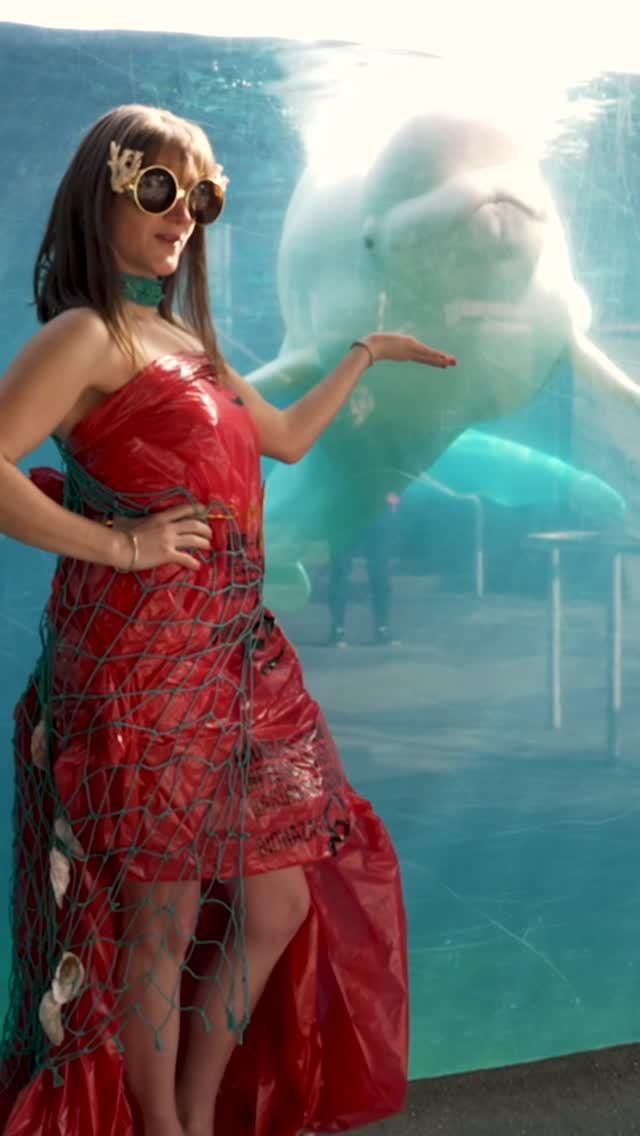- Impact of human activities on the oceans
- Creative representation through ocean-themed fashion
- The role of aquaculture in ocean conservation
- Significance of upcycling and eco-friendly practices
- Collaborative efforts in environmental advocacy
Human activities have long left an indelible mark on the planet’s oceans. As the primary life source covering over 70% of the Earth’s surface, these vast bodies of water are critical for maintaining biodiversity, supporting various ecosystems, and providing resources for human consumption and enjoyment. Yet, pollution, overfishing, and climate change threaten these integral ecosystems. Raising awareness of these challenges is crucial, and creative approaches like fashion can serve as powerful tools for education and advocacy.
This Earth Day, a unique initiative took shape at the Mystic Aquarium, where a dress designed by the research department spotlighted the devastating impacts of human activity on marine environments. Constructed from biohazard waste disposal bags, the dress symbolizes the pervasive presence of medical waste and plastics infiltrating aquatic ecosystems. These materials have raised significant environmental challenges, contributing to habitat destruction and posing existential risks to marine life.
Plastics in the ocean are a growing concern, with billions of tons spilled into waterways annually. The ocean currents distribute this debris globally, forming massive garbage patches and endangering marine species that mistake these items for food. Understanding the enormity of this problem underscores the importance of reducing reliance on single-use plastics and advocating for better waste management practices worldwide.
The dress is wrapped in a net, symbolizing both trash in the oceans and significant fishing pressures. Overfishing diminishes fish populations vital for maintaining ecological balance. Simultaneously, discarded fishing nets and gear, often termed "ghost nets," pose their own hazards. These items ensnare countless marine animals, from turtles to dolphins, leading to injury or death. Reducing fishing pressures and developing sustainable practices are essential paths toward preserving ocean biodiversity.
Accents of dead and bleached corals embellishing the dress signify the drastic impact of ocean warming and acidification, direct consequences of climate change. Coral reefs are often described as the rainforests of the sea due to their rich biodiversity. Yet, rising sea temperatures lead to coral bleaching, undermining the reefs’ health and the myriad species that depend on them. Moreover, ocean acidification, resulting from increased CO2 absorption, weakens corals’ ability to build their calcium carbonate skeletons. Addressing climate change is paramount in safeguarding these vital marine ecosystems.
A belt crafted from old crafting wires and fashioned into an audiogram helps bring attention to another pressing issue: ocean noise. Human-induced sound, from shipping, sonar, and industrial activities, significantly disrupts marine life, particularly species dependent on echolocation and sensitive to acoustic environments. Efforts to mitigate ocean noise through quieter technology and better regulation are vital steps forward.
Contrasting these impacts, the dress’s upcycled oyster shells, provided by Sixpenny Oyster Farm in Noank, CT, highlight the potential of aquaculture as a sustainable practice. Aquaculture, when managed correctly, helps reduce the strain on wild fish populations by providing a renewable seafood source. Additionally, filter-feeding shellfish like oysters naturally enhance water quality by removing particulates and pollutants, demonstrating aquaculture’s environmental benefits.
Upcycling, the creative re-use of discarded materials, is increasingly gaining traction as an eco-friendly practice. It reduces waste, conserves resources, and lessens the burden on landfills. In the case of this dress, upcycled materials not only provide a striking visual narrative but also promote recycling as an impactful habit individuals can adopt to help protect the environment.
The collaboration between Dr. Laura Thompson, Susan Smith, Danielle Lavoie, Dr. Ebru Unal, and Dr. Tracy Romano in realizing this innovative project reinforces the strength of collective environmental advocacy. Each member’s expertise contributes to a comprehensive representation of oceanic issues and the urgency of addressing them. Unified efforts in research, conservation, and education can drive significant progress in safeguarding our oceans for future generations.
Through initiatives like this Earth Day project, the importance of ocean conservation and sustainable practices becomes tangible and compelling. Fashion becomes more than an art form; it transforms into a medium for dialogue, contemplation, and action, urging individuals to become stewards of the world they inhabit.
The impact of human activities on oceans is multifaceted, affecting marine life and global ecological balance. As our understanding of these issues deepens, so too must our commitment to implementing solutions. By drawing inspiration from creative endeavors and fostering collaboration, we can begin to unravel the damage of our past actions and forge new pathways to maritime sustainability.
*****
Source Description
We’re getting a little trashy this Earth Day…
This dress, designed by the Mystic Aquarium research department represents multiple impacts of human activity on the oceans, a common theme among research and conservation efforts of the Aquarium. The dress itself is made of biohazard waste disposal bags, representing medical waste and general plastics in the environment, and is wrapped with a net representing not only trash in the oceans, but also fishing pressures and the entanglement of marine animals. A belt made of old crafting wire, is fashioned into the resemblance of an audiogram representing ocean noise, while accents of dead and bleached corals mark the impact of ocean warming and acidification.
Upcycled oyster shells, provided the Sixpenny Oyster Farm in Noank CT, contrast these impacts by representing aquaculture efforts which can act to alleviate fishing practices and even help clean up coastal waters.
Designed by: Dr. Laura Thompson, Susan Smith, Danielle Lavoie, Dr Ebru Unal, Dr Tracy Romano


